English folklore
This article has multiple issues. Please help or discuss these issues on the talk page. (Learn how and when to remove these template messages)
|
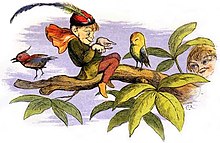
| Culture of England |
|---|
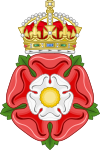 |
| History |
| People |
| Languages |
| Cuisine |
| Religion |
| Art |
| Literature |
|
English folklore consists of the myths and legends of England, including the English region's mythical creatures, traditional recipes, urban legends, proverbs, superstitions, and folktales. Its cultural history is rooted in Celtic, Christian, and Germanic folklore.[1]
During the Renaissance in the 16th century, England looked to more European texts to develop a national identity. English folklore has continued to differ according to region, although there are shared elements across the country.[2]
Its folktales include the traditional Robin Hood tales and the Brythonic-inspired Arthurian legend, and their stories often contained a moral imperative stemming from Christian values.[3] The folktales, characters and creatures are often derived from aspects of English experience, such as topology, architecture, real people, or real events.[4]
History[]
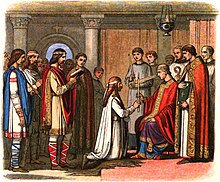
Before England was founded in the year 927, Wessex and its surrounding areas' cultures were transformed by the invasion of the Danish King Guthrum between 865 and 878.[5] The king of Wessex, King Alfred, prevailed against King Guthrum's troops in 878 and King Guthrum was baptised and became the ruler of Chippenham. Norse words were then introduced into the English language, and eventually English folklore melded with Norse traditions such as in their iconography, which became more Greek, and in their clothing and folktales which adopted more Nordic elements.[6] The folklore the people of England continued to be passed down through oral tradition.[1]
During the Renaissance, artists captured these customs in the written word; such as William Shakespeare's plays reflections of English folklore through their witches, fairies, folk medicine, marriage and funeral customs, superstitions, and religious beliefs.[1]
The Grimm brothers' publications such as German Legends and Grimms' Fairy Tales were translated from their original German and distributed across Europe in 1816. Their stories inspired publishers such as William Thoms to compile legends from within English folklore and without to compose an English identity. The stories that the Grimm brothers collected were integrated into the English school curriculum throughout the 19th century as educators of morality.[2]
Characteristics[]
Although English Folklore has many influences, its largest are its Christian, Celtic and Germanic.[1] Non-Christian influences also defined English folklore up to the eleventh century, such as in their folksongs, celebrations and folktales.[7] An example is the 305 ballads collected by Francis James Child published during the English revival in the 19th century. During the English folksong revival, English artists scrambled to compose a national identity comprised of England's past folksongs and their contemporary musical influences.[8] Authors such as Francis James Child, Arthur Hugh Clough, and Chaucer made English folksong supranational due to the willingness to import other languages' words, pronunciations, and metres.[9] Other examples of non-Christian influences include the Wild Hunt which originates from wider Europe,[10] and Herne the Hunter which relates to the Germanic deity Woden.[11] The Abbots Bromley Horn Dance may represent a pre-Christian festival and the practice of Well dressing in the Peak District, which may date back to Anglo-Saxon or even Celtic times.[12] May Day celebrations such as the Maypole survive across much of England and Northern Europe.[13] Christmas practices such as decorating trees, the significance of holly, and Christmas carolling were born from the desire to escape from the harshness of winter around Europe.[14]
These combine to form a folklore which teaches that, through an upright and virtuous character, a person can achieve a successful life. Lullabies, songs, dances, games, folktales, and superstitions all imparted a religious and moral education, and form a person's sense of justice and Christianity. Children's games would often contain counting songs or gamifications of manners to ensure that a child was happy, healthy, and good.[3]
English folklore also included beliefs of the supernatural, including premonitions, curses, and magic,[15] and was common across all social classes.[16] It was not regarded with the same validity as scientific discoveries, but was made to be trusted by the repeated accounts of a magician or priest's clients who saw the ritual's spectacle and so inferred efficacy.[15] Even when such rituals failed, such as a 15th-century physician using a golden artifact to heal his patients, their failures were attributed to the fickleness of magic.[16]
As for English folktales, some such as Weber argue that they were passed down for the purpose of reflecting the grim realities of a child's life and hence instilled valued English morals and aesthetics.[17] Others such as Tatar would counter that these folktales' fantasies were so removed from reality that they were a form of escapism, imaginative expression, and linguistic appreciation.[18] Most folklorists would agree that the purpose of English folklore is to protect, entertain, and instruct on how to participate in a just and fair society.[19]
Folktales[]
Folklorists have developed frameworks such as the Aarne–Thompson-Uther index which categorise folktales first by types of folktales and then by consistent motifs.[20] While these stories and characters have differences according to the region of their origin, these motifs are such that there is a national identity of folktales through which these regions have interacted.[2]
There are likely many characters and stories that have never been recorded and hence were forgotten, but these folktales and their evolutions were often a product of contemporary figures, places, or events local to specific regions.[4] The below are only a small fraction of examples from the folktale types of English folklore.
Creatures[]
A dragon is a giant winged reptile that breathes fire or poison and is usually associated with waterfalls. The dragon is also present in Chinese, Egyptian, Mesoamerican and many other mythologies of the world. In the cultures of India, they are found in the traditions of [[[Jain]], Hindu, and Buddhist mythologies and folklore.[21]
A Wyvern is a smaller relative of dragons with two legs rather than four. It also has smaller wings and cannot breathe fire.[22]
The black dog is a creature which foreshadows calamity or causes it. It is a combination of Odysseus' Argos and Hades' Cerberus from Greek mythology, and Fenrir from Norse mythology.[23] The first collection of sightings of the black dog around Great Britain, Ethel Rudkin's 1938 article reports that the dog has black fur, abnormally large eyes, and a huge body.[24]
A boggart is, depending on local or regional tradition, either or a malevolent genius loci inhabiting fields, marshes or other topographical features. The household boggart causes things to disappear, milk to sour, and dogs to go lame, and they can possess small animals, fields, churches, or houses so they can play tricks on the civilians with their chilling laugh. Always malevolent, the boggart will follow its family wherever they flee. In Northern England, at least, there was the belief that the boggart should never be named, for when the boggart was given a name, it would not be reasoned with nor persuaded, but would become uncontrollable and destructive.[25]
A brownie is a type of hob (household spirit), similar to a hobgoblin. Brownies are said to inhabit houses and aid in tasks around the house. However, they do not like to be seen and will only work at night, traditionally in exchange for small gifts or food. Among food, they especially enjoy porridge and honey. They usually abandon the house if their gifts are called payments, or if the owners of the house misuse them. Brownies make their homes in an unused part of the house.[26]
A dwarf is a human-shaped entity that dwells in mountains and in the earth, and is associated with wisdom, smithing, mining, and crafting. The term had only started to be used in the 19th century as a translation for the German, French, and Scandinavian words which describe dwarves.[27]
Ogres are usually tall, strong, violent, greedy, and remarkably dull monsters and they originate from French culture. In folktales they are likely to be defeated by being outsmarted.[28]
The Will-o'-the-wisp is a folk explanation of strange, flickering lights seen around marshes and bogs.[29] Some perceive them as souls of unbaptized infants which lead travellers off the forest path and into danger, while others perceive them as trickster fairies or sprites.[30]
Characters and personifications[]
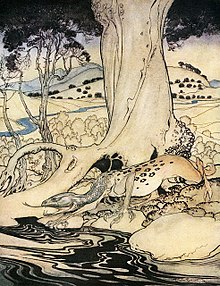
King Arthur is the legendary king of the Britons, the Once and Future King and True Born King of England. The origins of King Arthur and his exploits are vague due to the many reproductions of his character. The Historia Brittonum and the Annales Cambriae reference many battles of an Arthur, Annales Cambriae also referencing Mordred, a rival, and Merlin, a wise mentor. Although these sources have been used as proof for Arthur's origins, their credibility has been disputed as mythology rather than history.[31] As English folklore has progressed, King Arthur's retellings have been classified into romances such as Malory's Morte Darthur, chronicles such as Geoffrey's Historia Regum Brittaniae, and fantasies such as Culhwch ac Olwen (whose author is unknown).[32]
Robin Hood was a vicious outlaw who expressed the working-class' disenchantment with the status quo.[33] Through Robin Hood, the forest (called the "greenwood" by folklorists) transformed from the dangerous, mystical battleground of Arthur to a site of sanctuary, comradery, and lawlessness.[34] Rather than a philanthropic thief of the rich, Robin Hood began in the 15th century as a brutal outlaw, ballads revelling in his violent retaliation to threats. Robin Hood fought to protect himself and his group the Merry Men, regardless the class, age, or gender of their enemy. In stories such as 'Robin Hood and the Widow's Three Sons' and 'The Tale of Gamelyn', the joyful ending is in the hanging of the sheriff and the officials; in 'Robin Hood and the Monk', Robin Hood kills a monk and his young helper. Paradoxical to English values of strict adherence to the law and honour, Robin Hood was glorified in ballads and stories for his banishment from society. [33]
Robin Goodfellow, or Puck, is a shape-changing fairy known for his tricks. Since some English superstition suspected that fairies were demons, 17th century publications such as 'Robin Good-Fellow, his Mad Prankes and Merry Jests' and 'The Anatomy of Melancholy' portrayed him as a demon.[27]
Lob, also called loby, looby, lubbard, lubber, or lubberkin, is the name given to a fairy with a dark raincloud as a body. It has a mischievous character and can describe any fairy-like creature from British folklore. It can be confused with Lob Lie-By-The-Fire, a strong, hairy giant which helps humans.[35]
The Wandering Jew, also called Ahasver, Ahasverus or Ahaswer, is a character originating from an English Catholic monastery. Either named as a shoemaker or Pontius Pilate's doorman, he insulted Jesus Christ as he carried the cross. He was cursed with immortality until the Second Coming.[36]
Stories[]
Beowulf is an anonymous historical epic of 3182 lines which describes the adventures of its titular character, prince Beowulf of Geats. The story goes that Beowulf slays Grendel, a monster who has tormented the hall of Hrothgar King of the Danes for twelve years. Grendel's mother seeks to gain revenge and Beowulf slays her also, after which Beowulf becomes king of the Danes himself. After 50 years, Beowulf's people are tormented by a dragon and Beowulf dies while slaying her.[38] Original speculation was that Beowulf was a Scandinavian epic translated to English, theorised due to the story's Scandinavian settings. However, Beowulf was cemented as an Old English epic through the study that heroes of folklore are not ordinarily natives of the country they save.[39]
The Brown Lady of Raynham is a story of the ghost of a woman of Norfolk, Lady Dorothy Walpole. After her adultery was discovered, she was confined to her chambers until death and roamed the halls of Raynham, named after the brown brocade she wears. Differing versions of the story attest that she was locked in by her husband, Lord Townsend, or by the Countess of Wharton.[40]
The Legend of the Mistletoe Bough is a ghost story which has been associated with many mansions and stately homes in England. The tale describes how a new bride, playing a game of hide-and-seek during her wedding breakfast, hid in a chest in an attic and was unable to escape. She was not discovered by her family and friends, and suffocated. The body was allegedly found many years later in the locked chest.[41]
Other types of Folklore[]
Beliefs and motifs[]
Standing stones are man-made stone structures made to stand up. Some small standing stones can also be arranged in groups to form miniliths.[42] Similar to these geological artefacts are hill figures. These are figures drawn into the countryside by digging into the ground and sometimes filling it in with a mineral of a contrasting colour. Examples are the Cerne Abbas Giant, the Uffington White Horse, and the Long Man of Wilmington and are the focus for folktales and beliefs.[43]
The Green Man is a description originating in 1939 which describes the engraved sculpture of a face with leaves growing from it in English architecture. His presence symbolises nature, but he is depicted differently according to where he is engraved and who carves him; on a church he may symbolise either inspiration or lust, or he may symbolise an ancient protector of travellers in a forest.[44] The phrase originated from 'whifflers' who dressed in leaves or hair to make way for processions during pageants from the 15th to 18th centuries.[27]
There was a belief that those born at the chime hours could see ghosts. The time differed according to region, usually based around the times of monk's prayer which were sometimes marked by a chime.[27]
Crop circles are formations of flattened cereal. While they have been speculated to have mysterious and often extraterrestrial origins, most crop circles have been proven to be hoaxes. Those made by Doug Bower and Dave Chorley across England in 1991 have since started chains of copycats around the world.[45]
Cunning folk was a term used to refer to male and female healers, magicians, conjurers, fortune-tellers, potion-makers, exorcists, or thieves. Such people were respected, feared and sometimes hunted for their breadth of knowledge which was suspected as supernatural.[46]
The wild hunt was a description of a menacing group of huntsmen which either rode across the sky or on lonely roads. Their presence was a hallmark of the perception of the countryside as a wild and mystical place.[47]
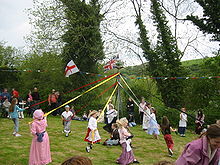
Practices[]
On May Day, the first day of May, a tall, decorated pole is put up as a symbol of fertility called a maypole. The maypole represents a phallic object impregnating the earth at the end of spring to ensure a bountiful summer. The maypoles were decorated originally with flowers and carved from the branches of trees about to bloom to symbolise the birth of new life. Eventually the flowers were replaced with ribbons and May day became a day for celebration and dancing in which a May queen and sometimes a May king would be crowned to also symbolise fertility.[48]
A parish ale is a type of party in the parish usually held to fundraise money for a particular purpose.[49]
Plough Monday was a custom in which, on the first Monday after Christmas, men visited people's doorsteps at night and asked for a token for the holiday. They carried whips and a makeshift plough and dug up the house's doorstep or scraper if the house refused to give them an item.[50]
Corn dollies are a form of straw work made as part of harvest customs of Europe before the First World War. Their use varied according to region: it may have been decorative, an image of pride for the harvest, or a way to mock nearby farms which had not yet collected their harvest. There has been a recent resurgence in their creation lead by Minnie Lambeth in the 1950s and 1960s through her book 'A Golden Dolly: The Art, Mystery, and History of Corn Dollies'.[51]
A superstition among children was that, if the first word uttered in the month was "Rabbit!", then that person would have good luck for the rest of the month. Variants include: "rabbit, rabbit, rabbit!", "rabbit, rabbit, white rabbit!", and "white rabbit!".[27]
After a person died, a poor person was hired to take on their sins by eating before or after the funeral over their body- a sin-eater. The sin-eater would hence ensure that the recently deceased would be taken to heaven.[52]
Items[]
Sir Francis Drake's Drum is a legend about the drum of an English admiral who raided Spanish treasure fleets and Spanish ports. He was believed to have white magic which enabled him to turn into a dragon (as hinted by his name, Drake meaning dragon in Latin). When he died, the drum which he brought on his voyage around the world was sung about- that in England's peril, they could strike it and he would come to their aid. Eventually the legend evolved to be that the drum would strike itself in England's peril, and it has been heard struck since.[53]
A hagstone, also called a holed stone or adder stone, is a type of stone, usually glassy, with a naturally occurring hole through it. Such stones have been discovered by archaeologists in both Britain and Egypt. In England it was used as a counter-charm for sleep paralysis, called hag-riding by tradition.[54]
A petrifying well is a well which, when items are placed into it, they appear to be covered in stone. Items also acquire a stony texture when left in the well for an extended period of time. Examples in England include Mother Shipton's Cave in Knaresborough and Matlock Bath in Derbyshire.[55]
Common Folklore[]
- Elf-arrow / Elfshot
- Merry England
- Nursery rhyme / Mother Goose
- Saint George's Day in England
- Tudor myth
Folklore local to specific areas[]
Folklore of East Anglia[]
|
|
Folklore of London and the South East[]
|
|
Folklore of the Midlands[]
|
|
Folklore of Yorkshire and the North East[]
|
|
Folklore of the North West[]
|
|
Folklore of the South West[]
|
|
See also[]
Legendary in the British Isles[]
Related Figures[]
- Cecil Sharp
- Sabine Baring-Gould
References[]
- ^ a b c d "English Folklore: What Cultural Values Does It Represent?". #FolkloreThursday. 2019-09-26. Retrieved 2021-12-30.
- ^ a b c Matthew Cheeseman; Carina Hart, eds. (2022). Folklore and nation in Britain and Ireland. New York. ISBN 978-1-003-00753-1. OCLC 1250431455.
- ^ a b Mingazova, Liailia; Sulteev, Rustem (2014). "Tatar and English Children's Folklore: Education in Folk Traditions". Western Folklore. 73: 410–431 – via ProQuest.
- ^ a b Simpson, Jacqueline (2008). "Seeking the Lore of the Land". Folklore. 119 (2): 131–141. doi:10.1080/00155870802056936. S2CID 162117834.
- ^ Atherton, Mark (2017). The Making of England: A New History of the Anglo-Saxon World. I.B. Tauris. pp. 59–75. ISBN 9781003007531.
- ^ Atherton, Mark (2017). The making of England : a new history of the Anglo-Saxon world. London. pp. 53–58. ISBN 978-1-78672-154-9. OCLC 975999502.
- ^ Hutton, Ronald (3 Nov 2010). "How Pagan Were Medieval English Peasants?". Folklore. 122 (3): 235–249. doi:10.1080/0015587X.2011.608262. S2CID 162281749 – via Taylor & Francis Online.
- ^ Richard, Sykes (1993). "The Evolution of Englishness in the English Folksong Revival, 1890-1914". Folk Music Journal. 6 (4): 446–490. JSTOR 4522437 – via JSTOR.
- ^ Phelan, Joseph (2019). "Arthur Hugh Clough, Francis James Child, and Mid-Victorian Chaucer". Studies in English Literature. 59 (4): 855–872. doi:10.1353/sel.2019.0037. hdl:2086/16572. S2CID 213125784 – via ProQuest.
- ^ Monroe, Alexei (15 Jan 2019). "The Wild Hunt: Nationalistic Anarchism and Neofeudalism Unleashed". Third Text. 32: 620–628. doi:10.1080/09528822.2018.1555302. S2CID 150174959 – via Taylor & Francis Online.
- ^ Bramwell, Peter (2009). "Herne the Hunter and the Green Man". Pagan Themes in Modern Children's Fiction. Macmillan Publishers. pp. 38–83. ISBN 978-0-230-23689-9.
- ^ Campbell, James. The Anglo-Saxons (1991) Page 241, with illustration. ISBN 0-14-014395-5
- ^ Hutton, Ronald. The Stations of the Sun: A History of the Ritual Year in Britain. Oxford University Press, 1996. pp. 218–225
- ^ Forbes, Bruce David (2007). "First There Was Winter". Christmas: A Candid History. University of California Press. pp. 1–14. ISBN 9780520933729.
- ^ a b Harte, Jeremy (2 March 2018). "Superstitious observations: fortune-telling in English folk culture". Time and Mind. 11: 67–88. doi:10.1080/1751696X.2018.1433357. S2CID 165848305 – via Taylor & Francis Online.
- ^ a b Bailey, Michael D. Fearful Spirits, Reasoned Follies : The Boundaries of Superstition in Late Medieval Europe. Cornell University Press. pp. 7–10. ISBN 9780801451447.
- ^ Weber, Eugen (1981). "Fairies and hard facts: The Reality of Folktales". Journal of the History of Ideas. 42 (1): 93–113. doi:10.2307/2709419. JSTOR 2709419.
- ^ Tatar, Maria (2010). "Why Fairy Tales Matter: The Performative and the Transformative". Western Folklore. 69: 55–64 – via ProQuest.
- ^ Avery, Gillian (1965). Nineteenth century children : heroes and heroines in English children's stories, 1780-1900. London: Hodder and Stoughton. pp. 8–11. ISBN 9789050054928.
- ^ Aarne, Antti (1961). The types of the folktale. Helsinki: Suomalainen Tiedeakatemia. pp. 5–19.
- ^ Blust, Robert (2000). "The Origin of Dragons". Anthropos. 95 (2): 519–536. JSTOR 40465957 – via JSTOR.
- ^ Snelling, Roy (2015). Dragons of Somerset. Spiritual Genesis Books. p. 13. ISBN 9781783016327.
- ^ Zmarzlinski, Adam (2020). "The Black Dog: Origins and Symbolic Characteristics of the Spectral Canine". Cultural Analysis. 18.
- ^ Rudkin, Ethel (1938). "The Black Dog". Folklore. 49 (2): 111–131. doi:10.1080/0015587X.1938.9718739. JSTOR 1257762 – via JSTOR.
- ^ Guiley, Rosemary Ellen. (2007). The Encyclopedia of Ghosts and Spirits. New York: Facts On File, Inc.
- ^ Martin, M. (1716). A description of the Western Islands of Scotland. London: A. Bell, pp. 391, 67.
- ^ a b c d e Simpson, Jacqueline; Roud, Steve (2003). A Dictionary of English Folklore. Oxford University Press. ISBN 9780191726644.
- ^ Warner, M. (1998). "Why do Ogres Eat Babies? Monstrous Paternity in Myths and Fairytales". Paternity and Fatherhood: 195–203. doi:10.1007/978-1-349-13816-6_18. ISBN 978-1-349-13818-0 – via Springer Link.
- ^ Silcock, Fred (1997). "A review of accounts of luminosity in Barn Owls Tyto alba". In Czechura, Gregory; Debus, Stephen J. S. (eds.). Australian raptor studies II (Birds of Australia Monograph 3). Hawthorn East: Birds Australia. ISBN 9781875122080 – via The Owl Pages.
- ^ Katharine Briggs (1976). An Encyclopedia of Fairies. Pantheon Books. p. 381. ISBN 0-394-40918-3
- ^ Green, Thomas (2007). Concepts of Arthur. Gloucestershire: Tempus. ISBN 9780752444611.
- ^ Fulton, Helen (2009). A companion to Arthurian literature. Chichester: Wiley-Blackwell. pp. 21–29. ISBN 9781444305838.
- ^ a b Assayed, Layān. (2015). The Medieval Rhymes of Robin Hood: An Inquiry into Outlaw Territory (Thesis). University of Haifa.
- ^ Keen, Maurice (2001). The Outlaws of Medieval Legend. Canada: Taylor & Francis Group. pp. 1–8. ISBN 0-203-35004-9.
- ^ Bane, Theresa (2013). Encyclopedia of Fairies in World Folklore and Mythology. McFarland & Company, Incorporated Publishers. p. 219. ISBN 0394409183.
- ^ "Ahasver, Ahasverus, Wandering Jew - People - Virtual Shtetl". 2016-01-12. Archived from the original on 12 January 2016. Retrieved 2022-01-04.
- ^ "The Project Gutenberg eBook of Beowulf: An Anglo-Saxon Epic Poem". www.gutenberg.org. Retrieved 2022-01-10.
- ^ Chambers, Raymond Wilson (2010). Beowulf: An introduction to the study of the poem with a discussion of the stories of Offa and Finn. Project Gutenberg. p. 2. ISBN 9781465512147.
- ^ Chambers, Raymond Wilson (2010). Beowulf: An Introduction to the Study of the Poem with a Discussion of the Stories of Offa and Finn. Project Gutenberg. pp. 98–100. ISBN 9781465512147.
- ^ Rye, W. (1877). "The Norfolk Antiquarian Miscellany". Samuel Miller and Co. 2: 292.
- ^ "The Mistletoe Bough". user.dialstart. Retrieved 10 Jan 2022.
{{cite web}}: CS1 maint: url-status (link) - ^ Gillings, Mark (2015). "Betylmania? - Small Standing Stones and the Megaliths of South-West Britain". Oxford Journal of Archaeology. 34: 207–233 – via Wiley Online Library.
- ^ Petrie, Flinders (1926). "The Hill Figures of England". The Antiquaries Journal. 7: 540–541. doi:10.1017/S0003581500057486 – via Cambridge University Press.
- ^ Varner, Gary (2006). Mythic Forest, the Green Man and the Spirit of Nature : The Re-Emergence of the Spirit of Nature from Ancient Times into Modern Society. Algora Publishing. pp. 5–10. ISBN 1-281-39562-5.
- ^ Schmidt, William E. (10 Sep 1991). "2 'Jovial Con Men' Demystify Those Crop Circles in Britain". New York Times.
{{cite web}}: CS1 maint: url-status (link) - ^ Davies, Owen (2007). Popular magic : cunning folk in English history. London: Hambledon Continuum. pp. vii–viii. ISBN 9786613202024.
- ^ Davies, Owen (11 June 2019). "The Wild Hunt in the Modern British Imagination". Folklore. 130 (2): 175–191. doi:10.1080/0015587X.2018.1493861. S2CID 166360154 – via Taylor & Francis Online.
- ^ Williams, Victoria (2017). "Volume 2: Adolescence and Early Adulthood". Celebrating Life Customs around the World : From Baby Showers to Funerals: Adolescence and Early Adulthood. ABC-CLIO. pp. 219–221. ISBN 9781440836596.
- ^ Brewer, Ebenezer Cobham (2001). Wordsworth Dictionary of Phrase and Fable. Wordsworth Editions Ltd. p. 132. ISBN 1840223103.
- ^ Jonas, M. C.; Partridge, J. B.; Leather, Ella M.; Potter, F. S. (1913). "Scraps of English Folklore, VII". Folklore. 24 (2): 234–241. doi:10.1080/0015587X.1913.9719566 – via Taylor & Francis Online.
- ^ Untiedt, Kenneth L. (2006). Folklore : In All of Us, in All We Do. Texas: University of North Texas Press. pp. 177–84. ISBN 9786611133061.
- ^ Jaine, Tom; Davidson, Alan (2014). The Oxford Companion to Food (3 ed.). Oxford University Press. ISBN 9780199677337.
- ^ Ditmas, E. M. R. (1974). "The Way Legends Grow". Folklore. 85 (4): 244–253. doi:10.1080/0015587X.1974.9716563. JSTOR 1259622 – via JSTOR.
- ^ Grose, Francis (1787). A provincial glossary, with a collection of local proverbs, and popular superstitions. London: S Hooper. p. 62.
- ^ Rutty, John (1757) A Methodical Synopsis of Mineral Waters, comprehending the most celebrated medicinal waters, both cold and hot, of Great-Britain, Ireland, France, Germany, and Italy, and several other parts of the world, London: William Johnston; p. 351
Further reading[]
- Briggs, K. M. "Possible Mythological Motifs in English Folktales". Folklore 83, no. 4 (1972): 265–71. Retrieved June 18, 2020. www.jstor.org/stable/1259424.
- Williamson, Craig; Kramer, Michael P; Lerner, L. Scott (2011). A Feast of Creatures: Anglo-Saxon Riddle-Songs. Philadelphia: University of Pennsylvania Press. ISBN 9780812211290.
- Sax, Boria (2015). "The Magic of Animals: English Witch Trials in the Perspective of Folklore". Anthrozoös. 22: 317–332 – via Taylor & Francis Online.
- Keegan-Phipps, Simon (29 Mar 2017). "Identifying the English: essentialism and multiculturalism in contemporary English folk music". Ethnomusicology Forum. 26: 3–25 – via Taylor & Francis Online.
- Opie, Iona; Opie, Peter (1987). The lore and language of schoolchildren. New York: Oxford University Press. ISBN 0192820591.
- Opie, Iona; Opie, Peter (1997). The Oxford Dictionary of Nursery Rhymes. New York: Oxford University Press. ISBN 0198600887.
- Opie, Iona; Tatem, Moira (1992). A Dictionary of Superstitions. New York: Oxford University Press. ISBN 9780191726873.
- Paynter, William H.; Semmens, Jason (2008). The Cornish Witch-finder: William Henry Paynter and the Witchery, Ghosts, Charms and Folklore of Cornwall. ISBN 090266039X.
- Vickery, Roy (1995). A dictionary of plant-lore. New York: Oxford University Press. ISBN 0198661835.
- Westwood, Jennifer; Simpson, Jacqueline (2005). The Lore of the Land: A Guide to England's Legends, from Spring-heeled Jack to the Witches of Warboys. Penguin Books. ISBN 9780141007113.
- Wright, Arthur Robinson (2013). English Folklore. Read Books. ISBN 9781473300231.
- Fee, Christopher R.; Leeming, David Adams (2004). Gods, Heroes, & Kings: The Battle for Mythic Britain. Oxford University Press. ISBN 9780195174038.
External links[]
- "Popular Rhymes and Nursery Tales" (1849), by James Halliwell, a discussion on the origin of English folk tales and rhymes.
- "Weather and Folk Lore of Peterborough and District:, by Charles Dack, 1911, from Project Gutenberg
- Project-IONA a repository of folk tales from England and the islands of the North Atlantic
- Folklore Society (UK)
- Pretanic World – Folklore and Folkbeliefs
- Dartmoor Legends
| Wikimedia Commons has media related to Folklore of England. |
- English folklore
- Folklore
- England
